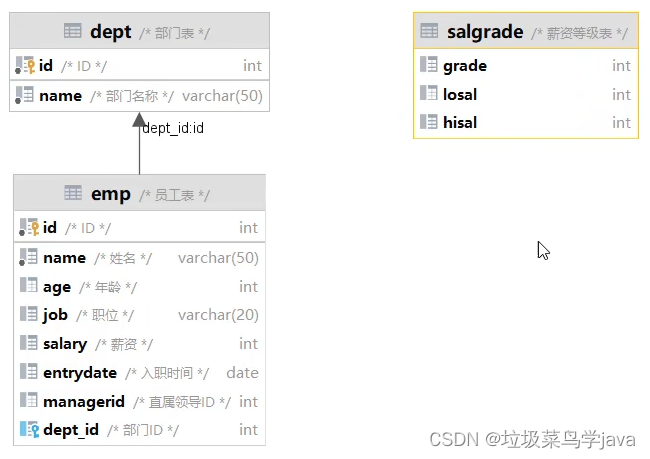一、多表关系
表结构之间的联系分为三种:
- 一对多:在多的一方建立外键,指向一的一方的主键

- 多对多:建立第三张中间表,中间表至少包含两个外键,分别关联两方主键

- 一对一:在任意一方加入外键,关联另外一方的主键,并且设置外键为唯一的(unique)

二、多表查询概述
- 概述:从多张表中进行数据查询
例如:
有以下两张表dept和emp:


现在想查询两张表的信息,并且让信息合并,则应该:
select * from emp , dept where emp.dept_id = dept.id;- 多表查询分类
1、连接查询
内连接:相当于查询A、B交集部分数据
外连接:
左外连接:查询左表所有数据,以及两张表交集部分数据(用的更多)
右外连接:查询右表所有数据,以及两张表交集部分数据
自连接:当前表与自身的连接查询,自连接必须使用表别名
2、子查询

三、内连接
- 隐式内连接

#查询每一个员工的姓名,以及关联的部门的名称
表结构:emp,dept
select emp.name,dept.name from emp,dept where emp.dept_id = dept.id;- 显示内连接

#查询每一个员工的姓名,以及关联的部门的名称
表结构:emp,dept
select emp.name,dept.name from emp inner join dept on emp.dept_id = dept.id;四、外连接
左外连接:

# 查询emp表的所有数据,和对应的部门信息
表结构:emp,dept
select emp.*,d.name from emp left outer jion dept on emp.dept_id = dept.id;右外连接:

# 查询dept表的所有数据,和对应的员工信息
表结构:emp,dept
select dept.*,emp.* from emp right outer jion dept on emp.dept_id = dept.id;五、自连接
语法:

自连接查询可以是内连接查询,也可以是外连接查询。
#查询员工以及所属领导的名字
表结构:emp
select a.name,b.name from emp a,emp b where a.managerid = b.id;
#查询所有员工emp以及领导的名字emp,如果员工没有领导,也需要查询出来
表结构:emp
select a.name,b.name from emp a left join emp b on a.managerid = b.id;六、联合查询:
概念:把多次查询的结果合并起来,形成一个新的查询结果集。

#将薪资低于五千的员工,和年龄大于50的员工全部查询出来
select * from emp where salary < 5000
union all
select * from emp where age > 50;将查询结果去重:
#将薪资低于五千的员工,和年龄大于50的员工全部查询出来
select * from emp where salary < 5000
union
select * from emp where age > 50;- 对于联合查询的多张表的列数必须保持一致,字段类型也需要保持一致。
- union all会将全部的数据直接合并在一起,union会对合并之后的数据去重。
七、子查询
概念:SQL语句中嵌套SELECT语句,称为嵌套查询,又叫做子查询。

子查询的外部语句可以是insert/update/delete/select的任何一个。
根据子查询结果不同,分为:
- 标量子查询
- 列子查询
- 行子查询
- 表子查询
根据子查询位置,分为:where之后、from之后、select之后。
标量子查询(子查询结果为单个值)
常用的操作符:>、<、=、<=、>=、<>
# 查询销售部的所有员工信息
select * from emp where dept_id=
(select id from dept where name = '销售部');
#查询在“方东白”入职之后的员工信息
select * from emp where entrydate >
(select entrydate from emp where name = '方东白');列子查询(子查询结果为一列)
常用的操作符:in、not in、any、some、all

#查询“销售部”和“市场部”的所有员工信息
select * from emp where dept_id in
(select id from dept where name='销售部' or name='市场部');
#查询比财务部所有人工资都高的员工信息
select * from emp where salary > all
(select salary from emp where dept_id = (select id from dept where name = '财务部'));
#查询比研发部其中任意一人工资高的员工信息
select * from emp where salary > any
(select salary from emp where dept_id = (select id from dept where name = '研发部');行子查询(子查询结果为一行)
常用操作符:=、<>、in、not in
#查询与“张无忌”的薪资以及直属领导相同的员工信息
select from emp where
(salary,managerid) = (select salary,managerid from emp where name = '张无忌');表子查询(子查询结果为多行多列)
常用操作符:in
#查询与“鹿杖客”、“宋远桥”的职位和薪资相同的员工信息
select * from emp where (job,salary) in
(select job,salary from emp where name=' 鹿杖客' or name='宋远桥');
#查询入职日期是“2006-01-01”之后的员工信息以及部门信息
select emp.*,dept.* from (select * from emp where entrydate > '2006-01-01')
left join dept on emp.dept_id = dept.id;八、多表查询案例

1、查询员工姓名、年龄、职位、部门信息
select e.name,e.age,e.job,d.name from emp e,dept d
where e.dept_id = d.id;2、查询年龄小于30岁的员工姓名、年龄、职位、部门信息
select e.name,e.age,e.job,d.name from emp e inner join dept d
on e.dept_id=d.id where e.age < 30;3、查询拥有员工的部门id、部门名称
select distinct d.id,d.name from emp e,dept d where e.dept_id = d.id;4、查询所有年龄大于40岁的员工,以及其归属的部门名称;如果员工没有分配部门,也需要展示出来
select e.* ,d.name from emp e left join dept d on e.dept_id=d.id
where e.age > 40;5、查询所有员工的工资等级
select e.*,s.grade from emp e, salgrade s
where e.salary between s.losal and s.hisal;6、查询研发部所有员工的信息以及工资等级
select e.*,s.grade from emp e,dept d,salgrade s
where e.dept_id=d.id and
(e.salary between s,losal and s.hisal) and
d.name='研发部';7、查询研发部员工的平均工资
select avg(e.salary) from emp e,dept d where e.dept_id = d.id and d.name = '研发部';8、查询工资比“灭绝”高的员工信息
select * from emp where salary > (select salary from emp where name='灭绝');9、查询比平均工资高的员工信息
select * from emp where salary > (select avg(salary) from emp);10、查询低于本部门平均工资的员工信息
select * from emp e2 where
e2.salary < (select avg(e1.salary) from emp e1 where e1.dept_id = e2.dept_id);11、查询所有的部门信息,并统计部门的员工人数
select d.id,d.name,(select count(*) from emp e where e.dept_id = d.id) '人数' from dept d;12、查询所有学生的选课情况,展示出学生名称,学号,课程名称

select s.name,s.no,c.name from student s,student_course sc,course c
where s.id = sc.studentid and sc.courseid = c.id;





















 2394
2394











 被折叠的 条评论
为什么被折叠?
被折叠的 条评论
为什么被折叠?








